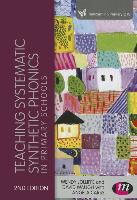Read more
Systematic synthetic phonics is a key strategy in the teaching of reading. This text supports trainee teachers working towards primary QTS in how to use phonics effectively. It explores what works in phonics teaching, and why.
It begins with the subject knowledge that underpins effective teaching and goes on to explore pedagogy from the early years to Key Stage 2. The book includes a review of different popular phonics programmes, set against the DfE (2011) criteria for high-quality phonics teaching.
This second edition has been updated in line with the new National Curriculum, includes new guidance on the Year 1 phonics screening check and new lessons ideas and practical guidance for teaching phonics.
List of contents
Section 1: Subject knowledge for teachers
Discriminating sounds and phonemes
Challenges
Grapheme-phoneme correspondences and 'tricky' or common exception words
Decoding and encoding text
Long vowel digraphs - the advanced alphabetic code
Phonics into spelling
Section 2: Effective pedagogy
Teaching phonics in the early years
Multi-sensory and interactive methods
Teaching a systematic structured progression
Planning for phonics
Tracking and assessing pupils' learning and effective intervention
Teaching phonics in Key Stage 2
Using a range of programmes and resources
Conclusion
Glossary
Model answers to self-assessment questions
Index
About the author
Dr Wendy Jolliffe is Head of Scarborough School of Education at the University of Hull and has strategic responsibility for Teacher Education. Her previous experience includes working as Regional Adviser for ITT for the National Strategies, running a range of courses in Education at the University of Hull and working as a Local Authority Advisory teacher for literacy.
Summary
The government prioritizes systematic synthetic phonics as a key strategy in the teaching of reading, this book provides a comprehensive guide to teaching systematic synthetic phonics in primary schools.

